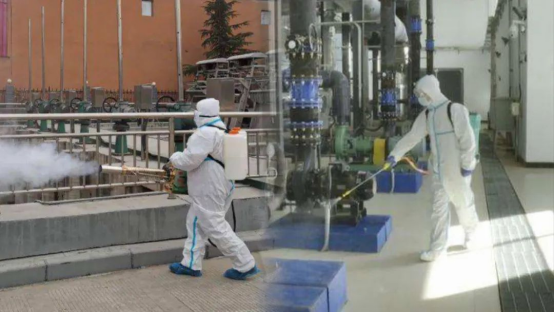Response measures that frontline water treatment workers should take during the current epidemic
1. The frontline of environmental protection during the "war against the epidemic", the heroes in a corner of the city who should not be forgotten
"Since the outbreak of the epidemic, the hearts of employees in the factory have been tense, especially those working on the front line." said the person in charge of a sewage treatment plant in Zhejiang.

Source/Internet: A sewage treatment plant strengthens epidemic prevention measures
On the one hand, the risk of virus exposure and infection is high, and frontline personnel themselves are under great pressure.
Water is an important medium for spreading viruses. The excrement of infected people contains a large amount of viruses. The excrement carrying the virus is discharged into the sewage treatment plant through the municipal pipe network and continues to maintain the ability to infect in the sewage for a certain period of time.
On the other hand, during the epidemic, the risk of effluent water quality exceeding standards is high, and frontline personnel are under great pressure.
Chlorine-containing disinfectants are used for disinfection in hospitals, public places and homes, and excessive dosage of disinfectants is common. This results in the presence of excess residual chlorine in sewage, which may inhibit sludge activity, thereby affecting the normal operation of the biochemical section of the sewage treatment plant and increasing the risk of effluent quality exceeding standards.
But despite this,
At the height of the epidemic
More than 5,000 sewage treatment plants across the country remain in normal operation
Environmental heroes on the front lines are still working hard to stay at their posts
Even if more than half of our colleagues are quarantined or working from home
They still held on firmly
The last line of defense for sewage treatment
"Unless the earth explodes, we will not have a holiday." Salute to the frontline workers of sewage treatment!
- The Omicron virus strain is coming fiercely, and frontline workers in sewage treatment plants are at higher risk of virus infection.
While the domestic epidemic control situation is excellent, Omicron is spreading at an unprecedented speed in 77 countries and regions around the world!
Research data shows that Omicron spreads more easily than Delta. The probability of infection within the home is 3.2 times greater than that of Delta, while the probability of infection outside the home is 2 times that of Delta.

It is reported that although there are no confirmed cases of the Omicron strain in Houston, the largest city in Texas, the virus has been detected in multiple sewage plants.
Between November 29 and 30, the city collected wastewater samples from 39 local sewage treatment plants for testing, and found that the Omicron strain was present in 8 of the sewage treatment plants.
This also means that this strain is present in almost one-fifth of Houston's wastewater treatment plants. The Houston Health Department pointed out that "the new coronavirus can be transmitted through feces," so they will regularly test wastewater, and the test data will help cut off the spread of the virus.
The "Poison King" Omicron has invaded the mainland of my country.
On December 13, Tianjin discovered that the Omicron variant of the new coronavirus was discovered for the first time in mainland China.
On December 14, Guangzhou discovered its first positive imported Omicron case.
It is worth mentioning that Omicron’s S protein has more than 30 mutations, and most current vaccines are made against the S protein, which means that past infections with other variants, 2-shot mRNA vaccines or adenovirus vector vaccines are basically It is impossible to guard against it. It can be said that Omi Kerong is like entering an uninhabited land.
In summary, the risk of virus exposure and infection for frontline personnel in sewage treatment plants will further increase.
- New mutant strains have emerged in two places in China, and operation and maintenance and laboratory personnel have become "high-risk" groups.
The Swiss health department's analysis of enterovirus surveillance in sewage plants shows that carrying viruses through aerosols poses a higher risk of infection to operators.
Because of this, the incidence of intestinal diseases among workers in sewage treatment plants is higher than the average of the social population.
Pretreatment sections such as sewage lifting pumping stations, coarse and fine grates, cyclonic sedimentation tanks and sludge dewatering rooms in urban sewage treatment plants are high-risk places and are the most likely to expose viruses and other pathogens and cause potential risks to operators. point.
As mentioned above, it has been determined that the neutralizing antibodies produced by two shots of mRNA vaccine or adenovirus vector vaccine against Omicron have dropped significantly (the neutralizing ability of three shots of inactivated Omicron needs to be confirmed by research). The original Vaccination methods are less effective.
It can be said that booster shots may not be optional now, but a must! Operation and maintenance personnel and laboratory personnel with a higher risk of infection should be prioritized for vaccination.

During the epidemic prevention and control period, the safety protection of front-line operating employees is crucial. The pretreatment section and desliming room of the sewage treatment plant are high-risk places, and the risk of exposure and infection is high during daily inspections and operations.
In order to reduce the risk of infection among front-line operators, the following measures can be taken based on the actual situation:
- On-site operators should strengthen their awareness of self-protection, wear masks, gloves and other basic protective equipment before taking up work, and try to avoid direct contact with sewage, sludge, gravel, screen residue, etc.
- Improve the level of protection for operations in the water inlet pump room, pretreatment section, sludge dehydration section, and water sampling for testing. In addition to masks and gloves, goggles and protective clothing should be equipped.
- Since the sewage plant needs to record data frequently, it is recommended to disinfect the pens, and finally use one pen per person to prevent cross-infection.
- Strengthen the disinfection of centralized exhaust outlets and require personnel to avoid the airflow from the exhaust outlets as much as possible.
- After completing the work, thoroughly clean and disinfect protective equipment in a timely manner, strengthen personal hygiene, and wash hands and disinfect frequently.
- Regularly disinfect the screen slag generated in the pretreatment section, and promptly arrange transportation vehicles to clean and transfer the screen slag.
- How to operate and protect sewage treatment plants safely during the epidemic ?
According to the "Diagnosis and Treatment Plan for Novel Coronavirus Pneumonia" issued by the National Health Commission, the new coronavirus is sensitive to ultraviolet rays and heat. Lipid solvents such as 56°C for 30 minutes, ether, 75% ethanol, and chlorine-containing disinfectant can effectively extinguish the virus.

Source/Internet: A certain sewage plant jointly prevents and controls the epidemic
So, how can sewage plants enhance the sterilization effect of treatment facilities?
- Extend the hydraulic retention time
By extending HRT, the effectiveness of each treatment unit in removing, inhibiting, and inactivating pathogenic bacteria is improved. Studies have shown that while the treatment units of urban sewage treatment plants remove pollutants, they also play a key prevention and control role in removing, inhibiting or killing pathogenic microorganisms.
- Increase the amount of aeration and dosage of chemicals
By increasing the aeration volume to reduce effluent ammonia nitrogen, increasing the input of chemicals to reduce effluent suspended solids, etc., the treatment effect can be improved, the survival ability of bacteria can be reduced, and the bactericidal effect can be enhanced.
Relevant studies have shown that the coronavirus survives longer in primary effluent than in secondary effluent, possibly due to the higher suspended solids content that prevents its inactivation. Moreover, sodium hypochlorite will react with ammonia nitrogen, affecting the dosage of sodium hypochlorite and the stability of residual chlorine during the disinfection stage.
Therefore, increasing cost investment and improving water quality treatment effects can effectively improve the sterilization effect of the disinfection process section of the sewage plant.
- Use "ultraviolet + sodium hypochlorite" combined disinfection methods to maintain disinfection intensity
The outbreak period is in winter, when the relative temperature is lower, and the lower the temperature, the longer the germs survive.
Therefore, it is effective for urban sewage treatment plants, especially urban sewage treatment plants in severe epidemic areas, to scientifically adopt the combined disinfection mode.
Improve the sterilization effect of tail water, ensure the water environment is free from pollution, and prevent the spread of the epidemic.
In order to strictly control the disinfection effect of effluent, a sewage treatment plant in Zhejiang adjusted the process to move the sodium hypochlorite dosing point forward, extend the disinfection contact time, and increased the dosage of sodium hypochlorite from the usual 5 mg/L to 10 mg/L.
It is worth mentioning that, unless there are special circumstances, the sewage plant can operate according to the technical plan and local requirements, and there is no need to specifically increase the use of chlorine-containing disinfectants.
my country's current urban sewage treatment plant effluent and recycled water quality standards meet the hygienic risk control requirements during the new coronavirus pneumonia epidemic.
Of course, if special circumstances arise and it is necessary to increase the dosage of disinfectant, activated carbon can be used at the end of the sewage treatment process to increase the dechlorination link. It is necessary to ensure that the tail water is discharged stably and up to standards.
final discussion
The Omikron is approaching fiercely. Can the daily maintenance of the sewage plant and its employees really be foolproof?
It is recommended that the environmental protection department should not only strengthen supervision, but also provide a certain degree of economic support. Areas such as hospitals or isolation points where conditions permit should also try to evenly discharge the treated sewage that meets the standards to avoid damaging the downstream sewage treatment plants. Shock to the biochemical treatment system.
Recommended Posts
-
In recent years, the hygienic condition of dental unit waterline (DUWL) has gradually received attention in China. At the same time, many local standards have been introduced. For example, Beijing issued "DB11/T 1703- 2019 Technical Specifications for Waterway Disinfection of Oral Comprehensive Treatment Units" on December 25th, 2019, while Zhejiang Province issued "DB33/T 2307-2021 Technical Specifications for Cleaning and Disinfection of Dental Waterway Systems" on January 29, 2021. In fact, various countries in the world have begun to pay attention to issues related to waterway pollution in dental treatment units much earlier, and have made relevant specifications. This article summarizes the standards of various countries in this regard as follows: Foreign standards related to the waterway of dental treatment units In 1996, the American De...




comment